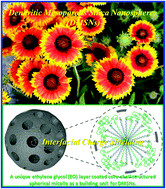Interfacial charge shielding directs the synthesis of dendritic mesoporous silica nanospheres by a dual-templating approach†
Abstract
We demonstrated a facile, dual-template method to synthesize uniform sized dendritic mesoporous silica nanospheres (DMSNs) with a large pore size via an interfacial charge shielding (ICS) approach, wherein the electrostatic interaction between the cationic surfactant micelle (S+) and the negative silicate species (I−) was precisely tuned by the deliberate use of a non-ionic co-surfactant with a varied chemical structure and number of ethyl oxide (EO) units. A universal ICS mechanism on the cationic spherical micelle surface by precisely tuning the {S+I−} interaction was proposed to explain the formation of conventional mesoporous silica nanospheres (MSNs) and DMSNs. Impressively, by precisely matching the hydrolysis and condensation rate of silicon and titanium sources, we successfully achieved the synthesis of titanium containing dendritic mesoporous silica nanospheres (Ti-DMSNs) with highly dispersed tetrahedral coordinated Ti atoms in silica frameworks, and it demonstrated a superior catalytic reactivity in the epoxidation of cyclohexene over the classical TS-1 and Ti-MCM-41. The elucidation of the formation mechanism of MSNs provided a new insight in the diversity-oriented synthesis of mesoporous materials.



 Please wait while we load your content...
Please wait while we load your content...